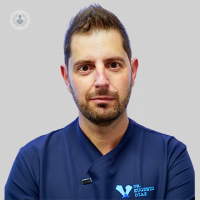Knee arthroscopy: how, when and why
Written by: Arthroscopic surgery has brought a revolution in surgery of joints, currently used for the treatment of many of the injuries that can occur in a joint. Very small surgical instruments, less than one centimeter, which are inserted into the joint through small incisions called portals are used.
Arthroscopic surgery has brought a revolution in surgery of joints, currently used for the treatment of many of the injuries that can occur in a joint. Very small surgical instruments, less than one centimeter, which are inserted into the joint through small incisions called portals are used.
Knee arthroscopy
Through the incisions we can view using a camera and a light beam inside the joint and thus repair of the knee tissues such as meniscus or cruciate ligaments.
Arthroscopic knee surgery should be performed in the treatment of fractures of the meniscus and cruciate ligaments. Meniscal injuries often cause freezing episodes or joint pseudobloqueo with knee hooked feeling.
The cruciate ligament injuries often cause instability in the knee. One of the most frequently treated injuries is rupture of the medial meniscus. Injuries to the cruciate ligaments are usually related to the sport. At other times required arthroscopic repair cartilage lesions related to traumatic events, rheumatologic diseases or infection.
Performing knee arthroscopy
In general traumatology , arthroscopy can be performed without problem to the majority of patients, outpatient surgery and be a little aggressive. Should not be performed if there is active infection in the skin near the surgery if there is stiffness or if there are significant changes in blood clotting.
Is there any risk?
Arthroscopic surgery is considered an outpatient surgery. The patient is discharged from hospital a few hours after surgery and can roam with crutches. The most frequently used anesthesia is epidural. As with all surgery there are risks, but are minimized by the ambulatory, small incisions and rapid recovery in activity.
Considerations and habits post knee arthroscopy
Following knee arthroscopy, you can restrict the support for a few weeks, or authorize the support rods from the outset on a per treatment. The subsequent recovery is usually marked by different protocols as appropriate. Meniscus surgery usually allow recovery from the daily activity on three or four weeks. Avoid sports intensity until three months after surgery, as needed strengthening and rebalancing muscular, especially quadriceps level.


